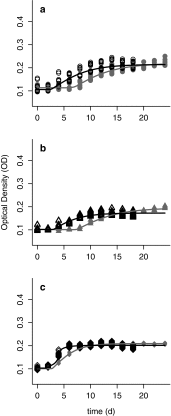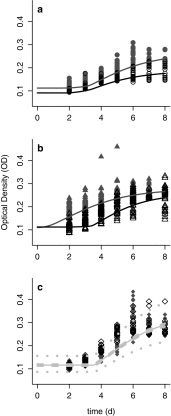Diversity in growth patterns among strains of the lethal fungal pathogen Batrachochytrium dendrobatidis across extended thermal optima
- PMID: 28424893
- PMCID: PMC5487841
- DOI: 10.1007/s00442-017-3866-8
Diversity in growth patterns among strains of the lethal fungal pathogen Batrachochytrium dendrobatidis across extended thermal optima
Abstract
The thermal sensitivities of organisms regulate a wide range of ecological interactions, including host-parasite dynamics. The effect of temperature on disease ecology can be remarkably complex in disease systems where the hosts are ectothermic and where thermal conditions constrain pathogen reproductive rates. Amphibian chytridiomycosis, caused by the pathogen Batrachochytrium dendrobatidis (Bd), is a lethal fungal disease that is influenced by temperature. However, recent temperature studies have produced contradictory findings, suggesting that our current understanding of thermal effects on Bd may be incomplete. We investigated how temperature affects three different Bd strains to evaluate diversity in thermal responses. We quantified growth across the entire thermal range of Bd, and beyond the known thermal limits (T max and T min). Our results show that all Bd strains remained viable and grew following 24 h freeze (-12 °C) and heat shock (28 °C) treatments. Additionally, we found that two Bd strains had higher logistic growth rates (r) and carrying capacities (K) at the upper and lower extremities of the temperature range, and especially in low temperature conditions (2-3 °C). In contrast, a third strain exhibited relatively lower growth rates and carrying capacities at these same thermal extremes. Overall, our results suggest that there is considerable variation among Bd strains in thermal tolerance, and they establish a new thermal sensitivity profile for Bd. More generally, our findings point toward important questions concerning the mechanisms that dictate fungal thermal tolerances and temperature-dependent pathogenesis in other fungal disease systems.
Keywords: Amphibian chytridiomycosis; Batrachochytrium dendrobatidis; Disease ecology; Psychrophilic fungi; Temperature.
Figures





Similar articles
-
Daily fluctuating temperatures decrease growth and reproduction rate of a lethal amphibian fungal pathogen in culture.BMC Ecol. 2020 Apr 3;20(1):18. doi: 10.1186/s12898-020-00286-7. BMC Ecol. 2020. PMID: 32245440 Free PMC article.
-
Interactions between Batrachochytrium dendrobatidis and its amphibian hosts: a review of pathogenesis and immunity.Microbes Infect. 2011 Jan;13(1):25-32. doi: 10.1016/j.micinf.2010.09.015. Epub 2010 Oct 14. Microbes Infect. 2011. PMID: 20951224 Review.
-
The Influence of Temperature on Chytridiomycosis In Vivo.Ecohealth. 2017 Dec;14(4):762-770. doi: 10.1007/s10393-017-1269-2. Epub 2017 Sep 6. Ecohealth. 2017. PMID: 28879516
-
Thermal Performance Curves of Multiple Isolates of Batrachochytrium dendrobatidis, a Lethal Pathogen of Amphibians.Front Vet Sci. 2021 Jun 22;8:687084. doi: 10.3389/fvets.2021.687084. eCollection 2021. Front Vet Sci. 2021. PMID: 34239916 Free PMC article.
-
Global emergence of Batrachochytrium dendrobatidis and amphibian chytridiomycosis in space, time, and host.Annu Rev Microbiol. 2009;63:291-310. doi: 10.1146/annurev.micro.091208.073435. Annu Rev Microbiol. 2009. PMID: 19575560 Review.
Cited by
-
Predicting the growth of the amphibian chytrid fungus in varying temperature environments.Ecol Evol. 2021 Dec 17;11(24):17920-17931. doi: 10.1002/ece3.8379. eCollection 2021 Dec. Ecol Evol. 2021. PMID: 35003647 Free PMC article.
-
Quantifying Batrachochytrium dendrobatidis and Batrachochytrium salamandrivorans Viability.Ecohealth. 2019 Jun;16(2):346-350. doi: 10.1007/s10393-019-01414-6. Epub 2019 May 23. Ecohealth. 2019. PMID: 31124019 Free PMC article.
-
Spontaneous reoccurrence of Batrachochytrium dendrobatidis infections in Australian green tree frogs (Litoria caerulea) following apparently successful heat therapy: Case report.Vet Res Commun. 2024 Oct;48(5):3229-3237. doi: 10.1007/s11259-024-10449-2. Epub 2024 Jul 1. Vet Res Commun. 2024. PMID: 38951465 Free PMC article.
-
Host and environmental factors drive prevalence of the pathogen Batrachochytrium dendrobatidis in Central African amphibians.Sci Rep. 2025 Apr 28;15(1):14908. doi: 10.1038/s41598-025-97367-8. Sci Rep. 2025. PMID: 40295564 Free PMC article.
-
Ecophysiological Suitability of Batrachochytrium dendrobatidis in Mexico.Ecohealth. 2025 Jul 15. doi: 10.1007/s10393-025-01734-w. Online ahead of print. Ecohealth. 2025. PMID: 40663216
References
-
- Blanford S, Thomas MB. Host thermal biology: the key to understanding host–pathogen interactions and microbial pest control? Agric For Entomol. 1999;1:195–202. doi: 10.1046/j.1461-9563.1999.00027.x. - DOI
MeSH terms
Grants and funding
LinkOut - more resources
Full Text Sources
Other Literature Sources
Medical
Molecular Biology Databases

